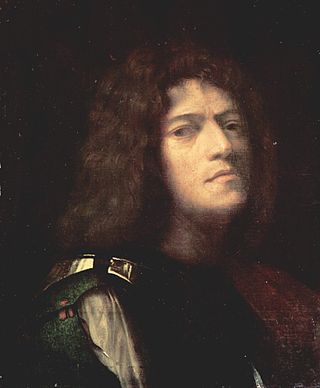
Giorgione was an Italian painter of the Venetian school during the High Renaissance, who died in his thirties. He is known for the elusive poetic quality of his work, though only about six surviving paintings are firmly attributed to him. The uncertainty surrounding the identity and meaning of his work has made Giorgione one of the most mysterious figures in European art.

Tiziano Vecelli or Vecellio, Latinized as Titianus, hence known in English as Titian, was an Italian (Venetian) Renaissance painter of Lombard origin, considered the most important member of the 16th-century Venetian school. He was born in Pieve di Cadore, near Belluno. During his lifetime he was often called da Cadore, 'from Cadore', taken from his native region.

Giovanni Bellini was an Italian Renaissance painter, probably the best known of the Bellini family of Venetian painters. He was raised in the household of Jacopo Bellini, formerly thought to have been his father, but now that familial generational relationship is questioned. An older brother, Gentile Bellini was more highly regarded than Giovanni during his lifetime, but the reverse is true today. His brother-in-law was Andrea Mantegna.

Antonello da Messina, properly Antonello di Giovanni di Antonio, but also called Antonello degli Antoni and Anglicized as Anthony of Messina, was an Italian painter from Messina, active during the Italian Early Renaissance.

Lorenzo Lotto was an Italian painter, draughtsman, and illustrator, traditionally placed in the Venetian school, though much of his career was spent in other north Italian cities. He painted mainly altarpieces, religious subjects and portraits. He was active during the High Renaissance and the first half of the Mannerist period, but his work maintained a generally similar High Renaissance style throughout his career, although his nervous and eccentric posings and distortions represented a transitional stage to the Florentine and Roman Mannerists.

The Barber Institute of Fine Arts is an art gallery and concert hall in Birmingham, England. It is situated in purpose-built premises on the campus of the University of Birmingham.

Vittore Carpaccio (UK: /kɑːrˈpætʃ oʊ/, US: /-ˈpɑːtʃ-/, Italian: [vitˈtoːre karˈpattʃo]; was an Italian painter of the Venetian school who studied under Gentile Bellini. Carpaccio was largely influenced by the style of the early Italian Renaissance painter Antonello da Messina, as well as Early Netherlandish painting. Although often compared to his mentor Gentile Bellini, Vittore Carpaccio's command of perspective, precise attention to architectural detail, themes of death, and use of bold color differentiated him from other Italian Renaissance artists. Many of his works display the religious themes and cross-cultural elements of art at the time; his portrayal of St. Augustine in His Study from 1502, reflects the popularity of collecting "exotic" and highly desired objects from different cultures.

BartolomeoMontagna was an Italian Renaissance painter who mainly worked in Vicenza. He also produced works in Venice, Verona, and Padua. He is most famous for his many Madonnas and his works are known for their soft figures and depiction of eccentric marble architecture. He is considered to be heavily influenced by Giovanni Bellini, in whose workshop he might have worked around 1470. Benedetto Montagna, a productive engraver, was his son and pupil and active until about 1540. He was mentioned in Vasari's Lives as a student of Andrea Mantegna but this is widely contested by art historians.

Alessandro Bonvicino, more commonly known as Moretto, or in Italian Il Moretto da Brescia, was an Italian Renaissance painter from Brescia, where he also mostly worked. His dated works span the period from 1524 to 1554, but he was already described as a master in 1516. He was mainly a painter of altarpieces that tend towards sedateness, mostly for churches in and around Brescia, but also in Bergamo, Milan, Verona, and Asola; many remain in the churches they were painted for. The majority of these are on canvas, but a considerable number, including some large pieces, are created on wood panels. There are only a few surviving drawings from the artist.

Marco Basaiti was a Venetian painter of Albanian origin who worked mainly in Venice during the Renaissance and was a contemporary of Giovanni Bellini and Cima da Conegliano. He has been referred to by several names including Marco Baxaiti, Marcus Basitus, and Marcus Baxiti. There is little documentation on Marco Basaiti besides his painting signatures and a guild's ledger of 1530 that records him as a painter of figures.

Saint Jerome in His Study is a painting by the Italian Renaissance master Antonello da Messina. The painting depicts human, natural, and divine knowledge, and is filled with architectural qualities. It was the property of Antonio Pasqualino and afterwards of Thomas Baring, 1st Earl of Northbrook; since 1894 it has been in the collection of the National Gallery, London.

St. Francis in Ecstasy is a painting by Italian Renaissance master Giovanni Bellini, started in 1475 and completed around 1480. Bellini depicted the religious figure of St. Francis of Assisi in a landscape. In 1852, the painting was listed on June 19 at Christie's. It was part of the 1857 Manchester Art Treasures exhibition. In 1915, Henry Clay Frick bought the painting for $170,000, and it remains in the Frick Collection, in New York City.

Italian Renaissance painting is the painting of the period beginning in the late 13th century and flourishing from the early 15th to late 16th centuries, occurring in the Italian Peninsula, which was at that time divided into many political states, some independent but others controlled by external powers. The painters of Renaissance Italy, although often attached to particular courts and with loyalties to particular towns, nonetheless wandered the length and breadth of Italy, often occupying a diplomatic status and disseminating artistic and philosophical ideas.
The decade of the 1450s in art involved many significant events, especially in sculpture.
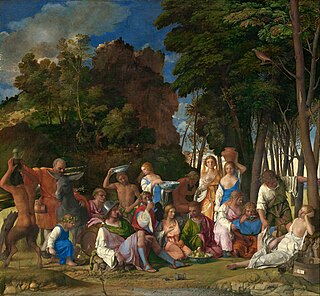
The Feast of the Gods is an oil painting by the Italian Renaissance master Giovanni Bellini, with substantial additions in stages to the left and center landscape by Dosso Dossi and Titian. It is one of the few mythological pictures by the Venetian artist. Completed in 1514, it was his last major work. It is now in the National Gallery of Art in Washington D.C., which calls it "one of the greatest Renaissance paintings in the United States".
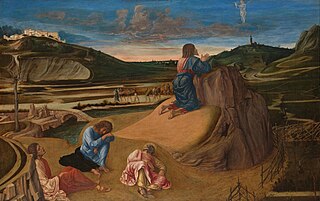
The Agony in the Garden is an early painting by the Italian Renaissance master Giovanni Bellini, who created it ca.1459–1465. It is a tempera painting on panel and is now in the National Gallery, London.
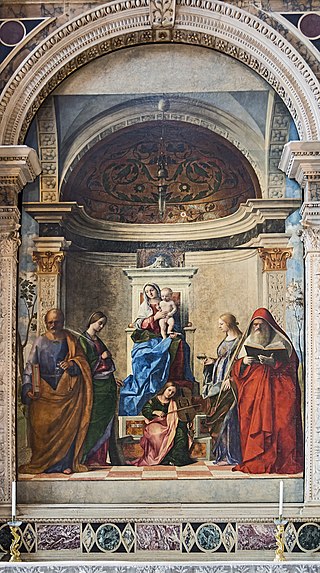
The San Zaccaria Altarpiece is a painting by the Italian Renaissance painter Giovanni Bellini, executed in 1505 and located in the church of San Zaccaria, Venice.
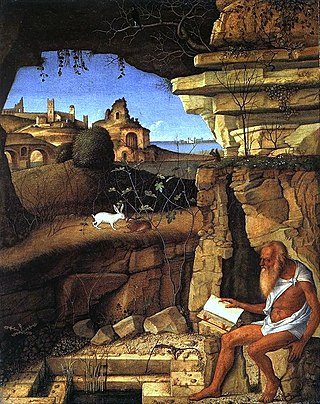
St. Jerome in the Desert is a 1505 oil-on-canvas painting by the Italian Renaissance master Giovanni Bellini, now in the National Gallery of Art in Washington. Little remains of the signature on the first rock in the left foreground, but it has been confirmed as genuine during restoration and can be reconstructed as "[Johannes Bellinu]s. 1505". This is problematic, since the work's general style is linked to fashions no later than 1490, whereas Bellini's style of figures and landscapes had already begun to be influenced by Giorgione by 1500, with the backgrounds more fused and unified in terms of atmosphere. The composition makes it more analogous to his earlier works, such as the c. 1480 St. Jerome in the Desert. The Washington work may have been a collaboration, a work completed by a pupil in Bellini's studio or left incomplete and only finished by Bellini himself much later.

St. Jerome in the Desert or St. Jerome Reading in the Desert is a 1480 oil-on-panel painting by the Italian Renaissance master Giovanni Bellini, now in the Uffizi Gallery in Florence as part of the Contini Bonacossi collection, giving it its alternative title of The Contini Bonacossi St. Jerome.

The Madonna and Child with St. John the Baptist and a Female Saint or the Giovanelli Sacred Conversation is an oil painting on panel by the Italian Renaissance master Giovanni Bellini, dated to before 1504. It is kept in the Gallerie dell'Accademia of Venice.



















